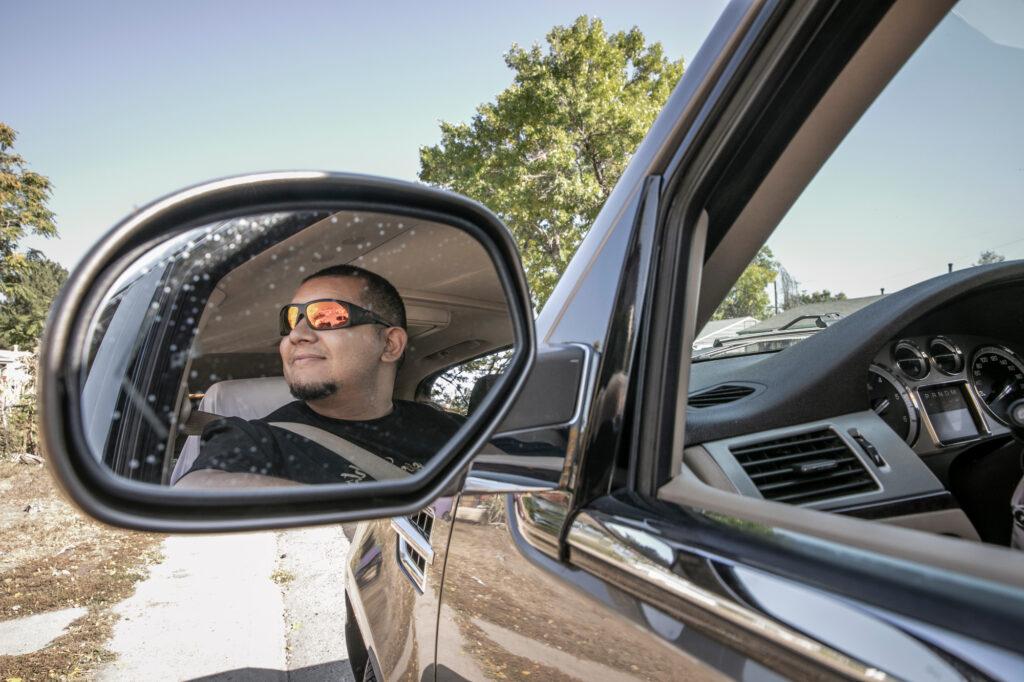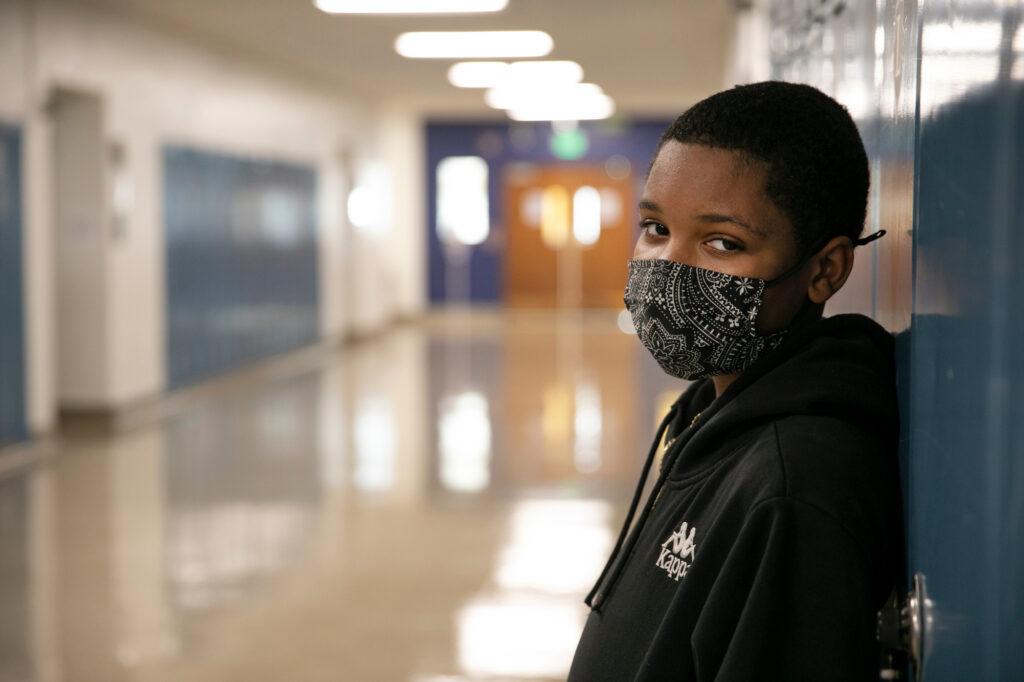
After years of low performance, a new administrative team at Denver’s Lake Middle School had just built up a school culture where kids felt respected, proud and accepted – the first step in improving academics. But that all came to a screeching halt when the pandemic hit. CPR News has chronicled the massive effort the school is undertaking now to try to re-engage hard-to-reach kids who are learning remotely at home and keep Lake’s culture alive.
Eighth-grade dean Dino Reyes Jr. hops inside the shiny Escalade driven by his friend and colleague sixth-grade dean Juan Rangel (a.k.a. Mr. Staxx). The flashy car with 24-inch tires gives three school deans clout when they roll up outside a student’s apartment.
“We’ve been trying to get ahold of these students for a couple of days now and they’re not answering,” Reyes says as he buckles in.
They’re working off of a list of students that teachers have flagged: students who haven’t shown up online at all or aren’t engaging with classes from home. Attendance averaged 77 percent in September. In the first week of October it was 81 percent and it's steadily been creeping up. Districtwide attendance is 88 percent.
As we roll past apartment complexes, Reyes ticks off the areas Lake’s 449 students come from: Barnum, Barnum West, Villa Park, Sun Valley, Avondale Apartments near Paco Sanchez Park, West Colfax, and parts of North Federal Boulevard, and the Clare Garden apartments.
They’re places Reyes knows like the back of his hand. He grew up here, in fact, was kicked out of the very middle school he now champions. As we cross the Lakewood Gulch, he and the other deans joke about catching crawdads from the creek when they were young, using little sausages from McDonald’s as bait.
At the first stop, dogs bark. Big dogs.
They try to push out the door to get a piece of Reyes. A young girl holds them back as Reyes asks if she’s OK and has Wi-Fi. He tells her they can bring by food, anything she needs. They bring her a T-shirt with her neighborhood’s name emblazoned on it.
“If you need anything holler at us,” Reyes calls out as he walks away.


90 percent of Lake’s students live in poverty. A third are English language learners.
Spanish teacher Joaquin Maiquez-Casas says he’s noticed many students are taking care of younger siblings as they try to learn online at home. He estimates his attendance is 60 percent, partially explained by the fact that his class is at the end of a long day.


He says the school mental health team is making lots of home visits, working with students on social and emotional issues, “trying to find out what kinds of supports they need to be successful.”
What Maiquez-Casas has noticed is the isolation: Students not having social relationships with other students, nor with other adults. “I always say that the school is not just learning math or learning Spanish, it’s also those relations that you build and how you grow up as a citizen with your partners and also adults.”
Just prior to COVID, the school was meeting its own attendance goals and the district’s attendance expectations. But when school began remotely this year, attendance was “atrocious,” says principal Amanda McDonald.
McDonald says the school is trying everything: homework attendance challenges with prizes, home-delivered pizza as a prize for attendance, $100 gift card lottery for attendance. Alongside the deans, the social worker, school counselor, psychologist, and the assistant principal all knock on doors, sometimes waking the kids up.
One effective method has been the attendance dialer. If a student doesn’t log on, an automatic phone call, text message, an email that goes to the parents. Parents call the school and say their child is online. The school responds that unfortunately, the child is not telling the truth, “which I know is mind-blowing, but they really thought that the kid’s in class all the time because the kids saying they are.”
Notifications ping the parent for each period of the day a child is not logged on.
“Shoot, we might as well roll up on Mr. Chavez too, since that’s right down the street,” Reyes says, back in the Escalade.
“I wonder if we can give him a call and say ‘hi’, make sure they’re OK and see who we are.”
The guys check in with the grandfather of two sixth graders new to the school. The father’s at work. Reyes says the girls have experienced a lot of trauma, including the fact that their mother died this year.

“They’re young girls … it’s really sad. The dad’s been trying to balance work,” his voice trails off.
The dad says they’re on the laptop when he leaves for work. But the school doesn’t see the girls logged on. Back and forth, it’s gone between the school and the dad. Grandpa gives them permission to swing by the girl’s apartment, Reyes jokes, enough time for the girls to quickly log on to school.
We climb up steps to the second floor of the apartment complex. When the girls open the door, Reyes explains in an upbeat way that the guys are just checking on them, making they’re OK because teachers haven’t seen them log on. How can the school help? The older sister to one of the girls, 14-year-old Nevaeh, speaks up.
“I’ve been sitting with them all day and they’ve been on their computers,” she says matter-of-factly.
“Well, it’s cool,” Reyes says. “You’re not in trouble, we’re just here to be supportive and have your back.”

Nevaeh says the girls would do better at the school’s remote learning support center. But with no district bus service now, there’s no way to get to the center. Reyes says he’s trying to figure out a way with their grandfather to get them to the center in the morning. Until then, a nudge:
“What’s funny and a lot of cats don’t know, that the district can see every single website that y’all go on and they also know when you’re logging in and when you’re not.” He said he just wants to make sure the girls are mindful of that when they’re on the school-issued laptops.
The 11-year-olds are quiet. But finally, the taller one, Alyssa, says this softly about online learning.
“It’s different and sometimes hard, and sometimes I don’t know what to do.”
The guys hand them neighborhood T-shirts, tell them to call if they need help and walk silently back to the car. Even little connections like these, says Reyes, build trust for when the girls are back inside school.
“That’s the first time I ever met them so it’s going to be hard to even jam ‘em up, like ‘I know y’all ain’t getting’ on, clearly you’re all on Netflix right now chillin',’” Reyes laughs.
But it’s also a sobering moment, one that doesn’t deter Reyes. He says it inspires him. The guys see the effects of isolation on the students, isolation from friends and from adults other than parents.
“Knowing that there’s a need, knowing that we feel like it’s our people, this is our culture, this is our responsibility, what can we do?”
Driving away, you know it wouldn’t be this bad if those 11-year-olds were in Lake Middle as it normally was.
Reyes knows the best-executed lesson plans won’t get all students logging on. There are other reasons some kids used to show up to school. It’s the culture he and staff members created inside the school starting two years ago.
Back in 2018 Lake was considered the lowest-performing school in Denver according to Denver’s school rating system.


Principal Amanda McDonald had a two-month window to plan and observe the school before she came on as principal and recalls: “I don’t even have a polite way to say it, it was just utter and total chaos.”
She said families had so many safety concerns, DPS assigned an additional 15 staff members just to man the hallways during passing periods. McDonald says a culture of distrust reigned. When the bell rang, teachers closed the doors and curtains and wouldn’t let in kids who were running late after a bathroom stop.
As the new principal, McDonald got to work. She rewrote every school system and structure, all of the big and small routines and procedures for how a school operates, to make it a “brand-new school.” Alongside those new systems, was the new culture Reyes, the eighth-grade dean, was ushering in.
“My goal was to get buy-in,” said Reyes. He explains many kids in poverty know they’re disenfranchised so they cling to an identity through gangs or becoming a basketball player or rapper.
He knew the school needed an identity to say “this is who we are, this is what we do as Knights.” The school’s mascot is a Knight, like the medieval King Arthur. The school, on the east side of Sloan’s Lake with its Moorish and Tudor-esque architecture, looks like a Castle. The team chose four virtues — honor, hard work, generosity and humility – as the new pillars upon which the school would stand on.
“When they're in the school setting, I wanted the identity to be on full display for them to see and for them to buy in,” he said. “Using those words in our vernacular, like, ‘Are you being honorable?’ making sure they know what that is, know what that looks like. We want them to embody those traits.”
The school held exuberant weekly assemblies highlighting a virtue and once a month, the students vote on who embodies those virtues. They’d come onto the stage, touch the shoulder of “Tuti” short for Arturo/Arthur, a large tin knight, and then touch their heart.

But Reyes wanted all the talk about honor, hard work, generosity and humility to be done in a way that reflects and respects the kids’ culture.
“They know I could still have my Jordans, my hoodie, my tattoos, and still be honorable, still be humble.”
Reyes drew upon the medieval theme, creating a barbershop called Castle Cuts. Kids could learn cosmetology and barbering skills and get a free Christmastime haircut from local stylists and barbers. The principal’s husband helped convert a storage room into a weight room. It’s called The Hall of Heroes. Kids painted the people who inspire them on the walls, Harriet Tubman, Biggie, Bob Marley, Muhammed Ali, community members.
Kids would come and let off steam there, unravel their feelings with a staff member, or just work out. There’s a DJ school and three school gardens, where kids planted or could just go to calm down.
“This is about building experiences, about making emotional investments,” said Lacy McDonald, the principal’s husband who volunteers at the school and conducts trips to the mountains. He plans to plant a thousand flower bulbs on the campus “because we’re going through these COVID times, I wanted to do something for the kids to express how I feel about them.”
Reyes says a key part of family buy-in is building pride in the neighborhoods, flipping the narrative of the embarrassment he felt as a boy coming from the projects.
“We're from Sun Valley, we're proud! We're from Barnum, from the Clare Gardens [apartment complex]. And so those kinds of things have been really shifting the students to feel like ‘they accept me. They're not trying to get me to assimilate into something that we're not.’”
Reyes has a four-phase plan that builds culture throughout the year until the kids begin to take ownership of it.
“It blows my mind that it works, and that it’s effective!” Reyes enthuses.
On the academic side, administrators completely overhauled how the school operated. Kids were just starting to grow academically. Bullying plummeted. School ratings bumped up. This spring was going to be big. Events were planned. Families bought in… and then, everything changed. The culture that kept kids in school disappeared.
Reyes and his team tried to get kids hyped for the beginning of the school year through highly produced, and entertaining, videos like this one. But for some kids, the challenge of learning online is just too great.
Back in the Escalade, Reyes explains all the layers of why some kids aren’t logging on.
Some just don’t like remote learning. They’re used to a teacher in front of them. And when they have technology, they’re used to it being just for fun.

“It’s like having your PlayStation and using that to write an essay, it’s like ‘What, I don’t want to do that!” Reyes says.
He says some kids don’t have the discipline. Others struggle with basic reading. Sixth-grade dean Juan Rangel, who is the driver today, says one barrier the school’s up against is one he knows well. He says his mom and aunts and uncles were pulled out of school young to work and help pay the bills.
“When it came to me growing up, my mom didn’t really stress school very much or education or the importance of it.”
He sees that in families, especially now, who are just trying to survive. Still, other kids just have a hard time getting up, like Jonathan Guerrero. It turns out the guys have wound up at the wrong house, Jonathan has the same name as another kid, but they get to meet Jonathan’s mom, Annetiga Nava.
“He gives me a fight every morning to get on,” she says of her son, “but once he’s on he’s pretty good.”
Jonathan says he gets tired a lot. The school day is too long, “until 3 so I get tired.” His mom explains that he has ADHD, “so it’s kind of harder for him to stay still and just focus on the computer in class.”
This is why the school is so passionate about getting kids back in person, says principal Amanda McDonald. Until then, Reyes encourages Jonathan to watch the Friday videos the deans make about the neighborhoods, like this one on Barnum, and the kids they visit to boost pride.
We’re coming up to Reyes’ favorite neighborhood.
“Ooh-wee, I love the Sun Valleys!” he says as we approach the 10-block housing project built in the 1950s, Colorado’s biggest affordable housing project.
Reyes grew up in the Sun Valley projects, where he says “you’ll find so much genuine realness here, a bunch of love, passion and blue-collar grit.” But soon they’ll all be torn down, part of the city’s plan for a new entertainment, business, art and multi-income housing district.


“It breaks my heart, it really does,” he said. “It feels like colonization…what are our students going to do?”
Move, it turns out. It’s noon and after a few knocks on the door, it turns out we’ve woken up eighth-grader Marcus Broadus — nickname Brody. He was up really late packing boxes into a U-Haul. No logging onto school today, “with all the stuff I have goin’ on.”
A construction truck passes by. Brody doesn’t know where the family’s going. In sixth grade he struggled a lot, had outbursts. The staff spent hours working with him. Brody spent a lot of time in the Hall of Heroes, the weight room where kids can calm down and talk about what they’re feeling. Staff say Brody’s improved leaps and bounds but still, Brody tells me he’s failing, “now it’s just like I don’t think I’m gonna make it to high school.”
But he wants to, he really does. Maybe he could be a cop one day.
“It just seems like I’d get to see more of the city, learn more.”
From Brody’s front door, you can see the city’s towering skyscrapers about three miles away. He’s glad he went to Lake.
“They have a lot of caring people there.”
He says Reyes is one of the nicest people he knows. He cares more than most.
“You make me cry right now Brody,” says Reyes.
Reyes gently urges the boy to tune into school tomorrow.
“If you need anything, we can cruise back by, I actually tried to call your mom earlier,” Reyes says. “You already know what to do, if you want to come by the school tomorrow if you need a ride or anything, just text mom —love you Brody.”
“Love you too,” says Brody.
Enrollment had grown every year, including this one, to 449. Lake’s staff is not losing hope but they worry about long term impacts of kids being out of in-person learning.
Principal McDonald says they’re losing students, even with home visits.
“My biggest fear is they’re losing potentially a year and a half or more of instruction and to me, that’s a gamechanger. They will never get that back.”


McDonald agrees that families get to make the choice about whether to come into the school. But it can be frustrating, especially for students who have not logged on at all. School staff have offered to bring them into the school’s remote learning center, where some students have said it’s easier to concentrate and get help there — but some families want to stay remote.
Until all of Lake’s student body can be back in the classroom, Dino Reyes will keep checking up on his kids, putting out videos of his visits in the neighborhood, as if to say:
“Remember this. This is who we are. Remember the fun we had. Remember how passionate we are for this community.” And Dino Reyes remembers Lake’s motto that he rediscovered in an old library book from the school he once got kicked out of: Semper Dienceps — Always forward. And just last week, attendance crept up to 94 percent.









